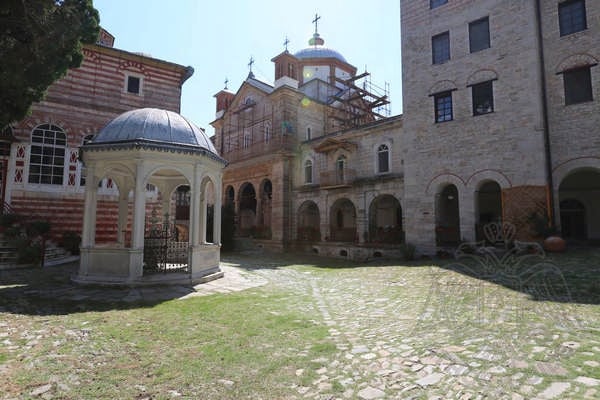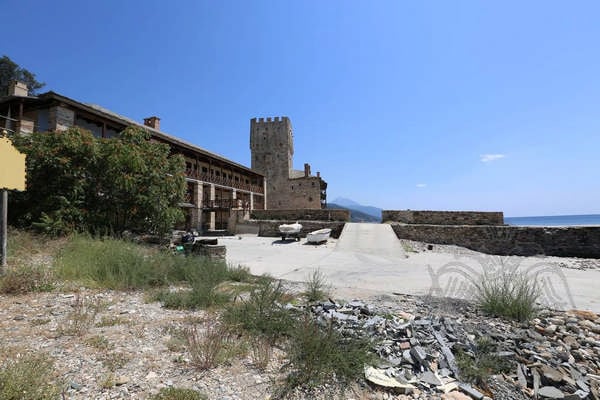History and present days
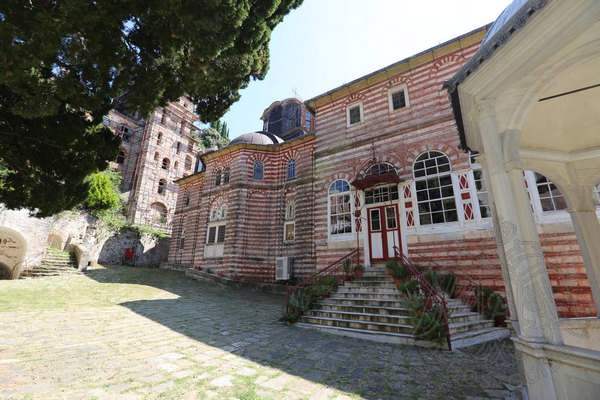
The uphill car road leads from the arsanas to the Monastery of Zographou (4 km, 1 hour and 25 minutes). The route is breathtaking. The vegetation is dense. Among the greenery, steep cliffs emerge. In spring, the blooming trees add a touch of color to the varied shades of green. The road with the stone bridge to the left leads to the Monastery of Hilandar.
The monastery dominates the right slope above the road. At the top of the hill on the opposite side of the stream, stands the Kathisma of Saint George, with its whitewashed church. A water mill was once in use in this place, until a few decades ago it was eventually abandoned. The present appearance of the monastery is the result of an ambitious building program carried out at the end of the 19th century. The floor plan has a quadrilateral shape. The masonry is characterized by a combination of stonework and ceramics. The south wing was renovated in 1716, while the north side, the facade, and the west wing were constructed between 1862 and 1896.
A particularly notable feature is the west wing, at the center of which there is a building with a dome. It clearly follows the type of the corresponding west wing of the Skete of Saint Andrew. The polygonal end of the building adds a touch of modern architecture to the otherwise austere monastic complex. From its balconies, one can overlook the gorge of the Gerakofolia stream, where Saint Cosmas of Zographou once lived as a hermit in a cave.
History
According to tradition, the foundation of the monastery dates to the reign of the Emperor Leo VI the Wise (886–912). The founders are said to have been three brothers, Moses, Aaron, and John, from Lychnidos (modern-day Ohrid). Since each of them wished to dedicate the monastery to a different saint (the Virgin Mary, Saint Nicholas and Saint George), they decided to place an unmarked wooden panel in the katholikon and pray throughout the night for divine guidance.
By the next morning, they found an icon of Saint George miraculously painted on the plank. Thus, the monastery was named "Saint George of Zographou" (Zographou meaning "Painter"). The name, therefore, refers to the title of Saint George rather than the name of the founders.
The monastery appears in the Typikon of the Emperor John I Tzimiskes (972). Its official foundation is considered to have taken place shortly thereafter, as it is mentioned in a document from 980. In the 13th century, it is claimed that Bulgarian monks inhabited the place. On October 10, 1276, during the conflicts that followed the Council of Lyon (1274), the abbot, 21 monks, and four laymen resisted the union with the Catholic church and became martyrs when soldiers set fire to the tower.
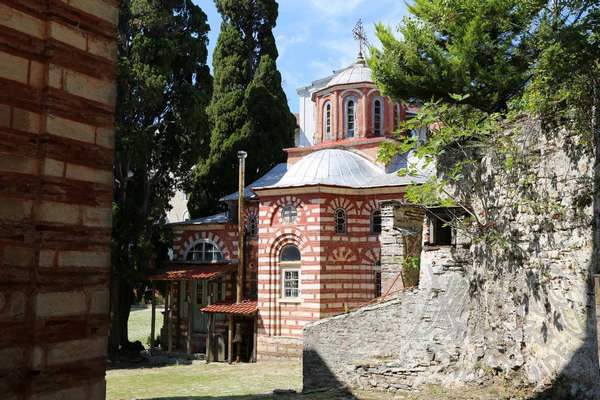
The monastery also suffered attacks from Catalan pirates but was restored and rebuilt thanks to donations from the Palaiologan emperors Andronikos II and John V, as well as from rulers of the Danubian principalities during the 15th century. After a brief period of prosperity, the monastery almost fell into total desolation. However, aid from the rulers of Hungary and Wallachia, particularly from Stephen the VI (1502), led to its revival. The renovation of the southeastern wing in 1716 marked the beginning of a new period of reconstruction and prosperity, rising especially during the second half of the 19th century, when the Monastery of Zographou became one of the wealthiest Athonite communities.
In 1746, the monastery acquired Jovanitsa from the Monastery of Esphigmenou. At the beginning of the 18th century, Greek monks have also settled in there, while the Divine Liturgy began to be chanted in both Greek and Bulgarian. In 1850, the monastery was officially recognized as a cenobitic monastery by the Patriarch Anthimos IV.
Throughout its history, the monastery has been home to numerous saints, including Saint Cosmas, Saint Pimen (†1620) and Saint Luke the Mytilenean (†1802, Mytilene).
Saint Cosmas of Zographou
Saint Cosmas is the most renowned ascetic and miracle-worker of the monastery. He possessed the spiritual gift of foresight, perceiving events in distant places and times. Born into a noble Bulgarian family, he received an extensive education but chose to leave the secular life behind, withdrawing to Mount Athos to avoid the prestigious career his parents had planned for him.
Initially, he entered communal life within the monastery. However, after hearing the voice of the Virgin Mary saying "Leave the monastery and practice alone," he withdrew to a cave northwest of the Zographou community. There, he lived in silence, battling demons and dedicating himself to asceticism. He is commemorated on September 22.
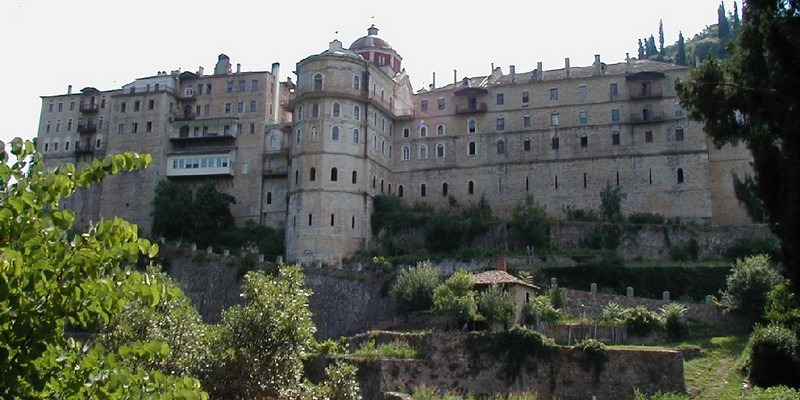
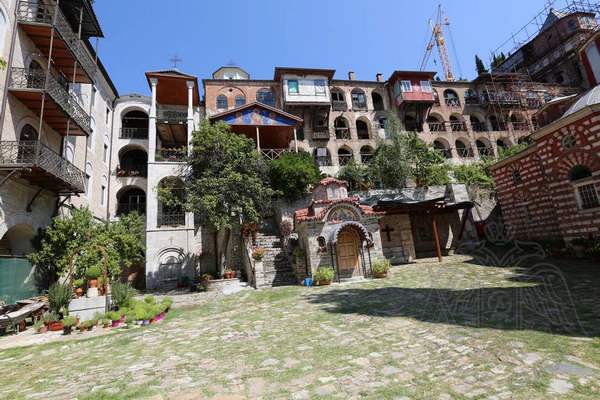 The main entrance is located on the north side and features a simple decorative facade. Opposite there stands the pavilion, which has a polygonal floor plan and a wooden roof. Further to the left there is the fountain of Saint Tryphon. The Bulgarians' notable dedication to geography is reflected in the elegant sign displaying the direction and distance of all nearby monasteries, of
The main entrance is located on the north side and features a simple decorative facade. Opposite there stands the pavilion, which has a polygonal floor plan and a wooden roof. Further to the left there is the fountain of Saint Tryphon. The Bulgarians' notable dedication to geography is reflected in the elegant sign displaying the direction and distance of all nearby monasteries, of 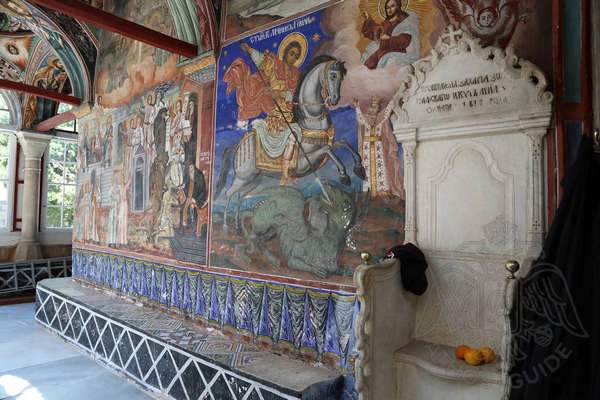 Church Frescoes and Decorations
Church Frescoes and Decorations